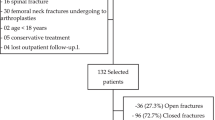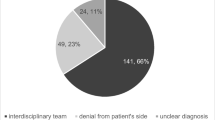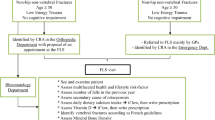Abstract
Summary
This study involving 674 elderly osteoporotic fracture (OPF) patients undergoing orthopedic surgery investigated the long-term outcomes of acute phase reaction (APR) after initial zoledronic acid (ZOL). Those who had an APR had a 97% higher risk of mortality and a 73% lower rate of re-fracture than patients who did not.
Introduction
Annual infusion of ZOL efficiently decreases the risk of fracture. A temporary APR, consisting of flu-like symptoms, myalgia, and fever, is frequently observed within 3 days after the first dose. This work aimed to identify whether the occurrence of APR after initial ZOL infusion is a reliable indicator of drug efficacy for mortality and re-fracture in elderly OPF patients undergoing orthopedic surgery.
Methods
This retrospectively observed work was constructed on a database prospectively collected from the Osteoporotic Fracture Registry System of a tertiary level A hospital in China. Six hundred seventy-four patients 50 years old or older with newly identified hip/morphological vertebral OPF who received ZOL for the first time after orthopedic surgery were included in the final analysis. APR was identified as a maximum axillary body temperature greater than 37.3 °C for the first 3 days after ZOL infusion. We utilized models of multivariate Cox proportional hazards to compare the risk of all-cause mortality in OPF patients with APR (APR+) and without APR (APR-). Competing risks regression analysis was used to examine the association between the occurrence of APR and re-fracture when mortality was taken into account.
Results
In a fully adjusted Cox proportional hazards model, APR+ patients had a significantly higher risk of death than APR- patients with a hazard ratio [HR] 1.97 (95% CI, 1.09–3.56; P-value = 0.02). Furthermore, in an adjusted competing risk regression analysis, APR+ patients had a significantly reduced risk of re-fracture compared with APR- patients with a sub-distribution HR, 0.27 (95% CI, 0.11–0.70; P-value = 0.007).
Conclusions
Our findings suggested a potential association between the occurrence of APR and increased mortality risk. An initial dose of ZOL following orthopedic surgery was found to be protective against re-fracture in older patients with OPFs.



Similar content being viewed by others
Data availability
The data that support the findings of this study are available from the corresponding author upon reasonable request.
References
Bachour F, Rizkallah M, Sebaaly A, Barakat A, Razzouk H, El Hage R et al (2017) Fracture liaison service: report on the first successful experience from the Middle East. Arch Osteoporos 12(1):79
van Geel TA, Huntjens KM, van den Bergh JP, Dinant GJ, Geusens PP (2010) Timing of subsequent fractures after an initial fracture. Curr Osteoporos Rep 8(3):118–122
van Geel TA, van Helden S, Geusens PP, Winkens B, Dinant GJ (2009) Clinical subsequent fractures cluster in time after first fractures. Ann Rheum Dis 68(1):99–102
Tran T, Bliuc D, Hansen L, Abrahamsen B, van den Bergh J, Eisman JA et al (2018) Persistence of Excess Mortality Following Individual Nonhip Fractures: A Relative Survival Analysis. J Clin Endocrinol Metab 103(9):3205–3214
Center JR, Nguyen TV, Schneider D, Sambrook PN, Eisman JA (1999) Mortality after all major types of osteoporotic fracture in men and women: an observational study. Lancet 353(9156):878–882
Russell RG (2006) Bisphosphonates: from bench to bedside. Ann N Y Acad Sci 1068:367–401
Devogelaer JP, Brown JP, Burckhardt P, Meunier PJ, Goemaere S, Lippuner K et al (2007) Zoledronic acid efficacy and safety over five years in postmenopausal osteoporosis. Osteoporos Int 18(9):1211–1218
Reid DM, Devogelaer JP, Saag K, Roux C, Lau CS, Reginster JY et al (2009) Zoledronic acid and risedronate in the prevention and treatment of glucocorticoid-induced osteoporosis (HORIZON): a multicentre, double-blind, double-dummy, randomised controlled trial. Lancet 373(9671):1253–1263
Lyles KW, Colón-Emeric CS, Magaziner JS, Adachi JD, Pieper CF, Mautalen C et al (2007) Zoledronic acid and clinical fractures and mortality after hip fracture. N Engl J Med 357(18):1799–1809
Boonen S, Reginster JY, Kaufman JM, Lippuner K, Zanchetta J, Langdahl B et al (2012) Fracture risk and zoledronic acid therapy in men with osteoporosis. N Engl J Med 367(18):1714–1723
Maricic M (2010) The role of zoledronic acid in the management of osteoporosis. Clin Rheumatol 29(10):1079–1084
Black DM, Delmas PD, Eastell R, Reid IR, Boonen S, Cauley JA et al (2007) Once-yearly zoledronic acid for treatment of postmenopausal osteoporosis. N Engl J Med 356(18):1809–1822
Reid IR, Gamble GD, Mesenbrink P, Lakatos P, Black DM (2010) Characterization of and risk factors for the acute-phase response after zoledronic acid. J Clin Endocrinol Metab 95(9):4380–4387
Black DM, Reid IR, Napoli N, Ewing SK, Shiraki M, Nakamura T et al (2022) The interaction of acute-phase reaction and efficacy for osteoporosis after zoledronic acid: HORIZON Pivotal Fracture Trial. J Bone Min Res Official J Am Soc Bone Min Res 37(1):21–28
Lu K, Shi Q, Gong YQ, Li C (2022) Association between vitamin D and zoledronate-induced acute-phase response fever risk in osteoporotic patients. Front Endocrinol (Lausanne). 13:991913
Lu K, Shi Q, Gong YQ, Shao JW, Li C (2022) Predicting the acute-phase response fever risk in bisphosphonate-naive osteoporotic patients receiving their first dose of zoledronate. Osteoporos Int 33(11):2381–2396
Wark JD, Bensen W, Recknor C, Ryabitseva O, Chiodo J 3rd, Mesenbrink P et al (2012) Treatment with acetaminophen/paracetamol or ibuprofen alleviates post-dose symptoms related to intravenous infusion with zoledronic acid 5 mg. Osteoporos Int 23(2):503–512
Okimoto N, Sakai A, Yoshioka T, Kobayashi T, Asano K, Akahoshi S et al (2020) Efficacy of non-steroidal anti-inflammatory drugs on zoledronic acid-induced acute-phase reactions: randomized, open-label, Japanese OZ study. J Bone Miner Metab 38(2):230–239
Charlson ME, Pompei P, Ales KL, MacKenzie CR (1987) A new method of classifying prognostic comorbidity in longitudinal studies: development and validation. J Chronic Dis 40(5):373–383
Varady NH, Gillinov SM, Yeung CM, Rudisill SS, Chen AF (2021) The Charlson and Elixhauser scores outperform the American Society of Anesthesiologists Score in assessing 1-year mortality risk after hip fracture surgery. Clin Ortho Related Res 479(9):1970–1979
Quan H, Sundararajan V, Halfon P, Fong A, Burnand B, Luthi JC et al (2005) Coding algorithms for defining comorbidities in ICD-9-CM and ICD-10 administrative data. Med Care 43(11):1130–1139
Quan H, Li B, Couris CM, Fushimi K, Graham P, Hider P et al (2011) Updating and validating the Charlson comorbidity index and score for risk adjustment in hospital discharge abstracts using data from 6 countries. Am J Epidemiol 173(6):676–682
Axelsson KF, Jacobsson R, Lund D, Lorentzon M (2016) Effectiveness of a minimal resource fracture liaison service. Osteoporos Int. 27(11):3165–3175
Kernan WN, Viscoli CM, Brass LM, Broderick JP, Brott T, Feldmann E et al (2000) Phenylpropanolamine and the risk of hemorrhagic stroke. N Engl J Med 343(25):1826–1832
Fine JP, Gray RJ (1999) A proportional hazards model for the subdistribution of a competing risk. J Am Stat Assoc 94(446):496–509
Olson K, Van Poznak C (2007) Significance and impact of bisphosphonate-induced acute phase responses. J Oncol Pharm Pract 13(4):223–229
Shiraki M, Kuroda T, Takeuchi Y, Sugimoto T, Tanaka S, Suzuki H et al (2021) Acute phase reactions after intravenous infusion of zoledronic acid in Japanese patients with osteoporosis: sub-analyses of the Phase III ZONE Study. Calcif Tissue Int 109(6):666–674
Ding Y, Zeng JC, Yin F, Zhang CL, Zhang Y, Li SX et al (2017) Multicenter study on observation of acute-phase responses after infusion of zoledronic acid 5 mg in Chinese Women with postmenopausal osteoporosis. Orthop Surg 9(3):284–289
Chen J, Yu L, Chen L, Wu X, Tang P, Yin J et al (2017) Surgical trauma and low-dose methylprednisolone modulate the severity of the acute-phase response induced by zoledronic acid infusion. Exp Ther Med 14(2):1802–1808
Roelofs AJ, Thompson K, Gordon S, Rogers MJ (2006) Molecular mechanisms of action of bisphosphonates: current status. Clin Cancer Res 12(20 Pt 2):6222s–6230s
Galluzzo S, Santini D, Vincenzi B, Caccamo N, Meraviglia F, Salerno A et al (2007) Immunomodulating role of bisphosphonates on human gamma delta T cells: an intriguing and promising aspect of their antitumour activity. Expert Opin Ther Targets 11(7):941–954
Gabay C, Kushner I (1999) Acute-phase proteins and other systemic responses to inflammation. N Engl J Med 340(6):448–454
Desborough JP (2000) The stress response to trauma and surgery. Br J Anaesth 85(1):109–117
Franceschi C, Campisi J (2014) Chronic inflammation (inflammaging) and its potential contribution to age-associated diseases. J Gerontol A Biol Sci Med Sci 69(Suppl 1):S4–S9
Capuron L, Schroecksnadel S, Féart C, Aubert A, Higueret D, Barberger-Gateau P et al (2011) Chronic low-grade inflammation in elderly persons is associated with altered tryptophan and tyrosine metabolism: role in neuropsychiatric symptoms. Biol Psychiatry 70(2):175–182
Bruunsgaard H, Skinhøj P, Pedersen AN, Schroll M, Pedersen BK (2000) Ageing, tumour necrosis factor-alpha (TNF-alpha) and atherosclerosis. Clin Exp Immunol 121(2):255–260
Bruunsgaard H, Andersen-Ranberg K, Jeune B, Pedersen AN, Skinhøj P, Pedersen BK (1999) A high plasma concentration of TNF-alpha is associated with dementia in centenarians. J Gerontol A Biol Sci Med Sci 54(7):M357–M364
Hasegawa Y, Sawada M, Ozaki N, Inagaki T, Suzumura A (2000) Increased soluble tumor necrosis factor receptor levels in the serum of elderly people. Gerontology 46(4):185–188
Ferrucci L, Corsi A, Lauretani F, Bandinelli S, Bartali B, Taub DD et al (2005) The origins of age-related proinflammatory state. Blood 105(6):2294–2299
García-Dabrio MC, Pujol-Moix N, Martinez-Perez A, Fontcuberta J, Souto JC, Soria JM et al (2012) Influence of age, gender and lifestyle in lymphocyte subsets: report from the Spanish Gait-2 Study. Acta Haematol 127(4):244–249
Valdiglesias V, Sánchez-Flores M, Maseda A, Marcos-Pérez D, Millán-Calenti JC, Pásaro E et al (2015) Lymphocyte subsets in a population of nonfrail elderly individuals. J Toxicol Environ Health A 78(13-14):790–804
de Araújo AL, Silva LC, Fernandes JR, Benard G (2013) Preventing or reversing immunosenescence: can exercise be an immunotherapy? Immunotherapy 5(8):879–893
De Martinis M, Franceschi C, Monti D, Ginaldi L (2006) Inflammation markers predicting frailty and mortality in the elderly. Exp Mol Pathol 80(3):219–227
Fülöp T, Larbi A, Pawelec G (2013) Human T cell aging and the impact of persistent viral infections. Front Immunol 4:271
Montecino-Rodriguez E, Berent-Maoz B, Dorshkind K (2013) Causes, consequences, and reversal of immune system aging. J Clin Invest 123(3):958–965
Fried LP, Tangen CM, Walston J, Newman AB, Hirsch C, Gottdiener J et al (2001) Frailty in older adults: evidence for a phenotype. J Gerontol A Biol Sci Med Sci 56(3):M146–M156
Morley JE, Vellas B, van Kan GA, Anker SD, Bauer JM, Bernabei R et al (2013) Frailty consensus: a call to action. J Am Med Dir Assoc 14(6):392–397
Soysal P, Stubbs B, Lucato P, Luchini C, Solmi M, Peluso R et al (2016) Inflammation and frailty in the elderly: A systematic review and meta-analysis. Ageing Res Rev 31:1–8
Bjarnason I, Scarpignato C, Holmgren E, Olszewski M, Rainsford KD, Lanas A (2018) Mechanisms of damage to the gastrointestinal tract from nonsteroidal anti-inflammatory drugs. Gastroenterology 154(3):500–514
Ungprasert P, Cheungpasitporn W, Crowson CS, Matteson EL (2015) Individual non-steroidal anti-inflammatory drugs and risk of acute kidney injury: A systematic review and meta-analysis of observational studies. Eur J Intern Med 26(4):285–291
Adami G, Fassio A, Gatti D, Viapiana O, Rossini M (2022) Acute phase reaction and fracture risk reduction: are gamma-delta T cells and hypovitaminosis D the missing link? J Bone Min Res Official J Am Soc Bone Min Res 37(8):1622
Barbour KE, Lui LY, Ensrud KE, Hillier TA, LeBlanc ES, Ing SW et al (2014) Inflammatory markers and risk of hip fracture in older white women: the study of osteoporotic fractures. J Bone Min Res Official J Am Soc Bone Min Res 29(9):2057–2064
Bertoldo F, Pancheri S, Zenari S, Boldini S, Giovanazzi B, Zanatta M et al (2010) Serum 25-hydroxyvitamin D levels modulate the acute-phase response associated with the first nitrogen-containing bisphosphonate infusion. J Bone Min Res Official J Am Soc Bone Min Res 25(3):447–454
Bhandari M, Bajammal S, Guyatt GH, Griffith L, Busse JW, Schünemann H et al (2005) Effect of bisphosphonates on periprosthetic bone mineral density after total joint arthroplasty. A meta-analysis. J Bone Joint Surg Am 87(2):293–301
Friedl G, Radl R, Stihsen C, Rehak P, Aigner R, Windhager R (2009) The effect of a single infusion of zoledronic acid on early implant migration in total hip arthroplasty. A randomized, double-blind, controlled trial. J Bone Joint Surg Am 91(2):274–281
Eriksen EF, Lyles KW, Colón-Emeric CS, Pieper CF, Magaziner JS, Adachi JD et al (2009) Antifracture efficacy and reduction of mortality in relation to timing of the first dose of zoledronic acid after hip fracture. J Bone Min Res Official J Am Soc Bone Min Res 24(7):1308–1313
Prieto-Alhambra D, Javaid MK, Judge A, Murray D, Carr A, Cooper C et al (2011) Association between bisphosphonate use and implant survival after primary total arthroplasty of the knee or hip: population based retrospective cohort study. BMJ 343:d7222
Chen F, Dai Z, Kang Y, Lv G, Keller ET, Jiang Y (2016) Effects of zoledronic acid on bone fusion in osteoporotic patients after lumbar fusion. Osteoporos Int 27(4):1469–1476
Koutalos AA, Chalatsis GI, Varsanis G, Malizos KN, Karachalios T (2022) The effect of zoledronic acid and high-dose vitamin D on function after hip fractures. A prospective cohort study. Eur J Orthop Surg Traumatol 32(6):1145–1152
Li YT, Cai HF, Zhang ZL (2015) Timing of the initiation of bisphosphonates after surgery for fracture healing: a systematic review and meta-analysis of randomized controlled trials. Osteoporos Int 26(2):431–441
Xue D, Li F, Chen G, Yan S, Pan Z (2014) Do bisphosphonates affect bone healing? A meta-analysis of randomized controlled trials. J Orthop Surg Res 9:45
Palui R, Durgia H, Sahoo J, Naik D, Kamalanathan S (2022) Timing of osteoporosis therapies following fracture: the current status. Ther Adv Endocrinol Metab 13:20420188221112904
Funding
The study was supported by China Postdoctoral Science Foundation (CN) (2022M711439), Elderly Health Research Project of Jiangsu Province (CN) (LKZ2022020), Suzhou Collaborative Innovation Research Project of Medical and Industrial Integration (CN) (SLJ2022023), Open Project of Jiangsu Provincial Key Laboratory of Geriatric Disease Prevention and Transformation (CN) (KJS2222), and Suzhou Key Clinical Diagnosis and Treatment Technology Project (CN) (LCZX202024).
Author information
Authors and Affiliations
Corresponding author
Ethics declarations
Ethics approval and consent to participate
We received ethical approval from the Affiliated Kunshan Hospital of Jiangsu University (approval No. 2020-03-046-K01) and was compliant with the Declaration of Helsinki. Patient identification data were hidden from the researchers analyzing the data. Written informed consent was not required because of the investigation’s observational and anonymous design.
Consent for publication
Not applicable.
Conflicts of interest
None.
Additional information
Publisher’s note
Springer Nature remains neutral with regard to jurisdictional claims in published maps and institutional affiliations.
Rights and permissions
Springer Nature or its licensor (e.g. a society or other partner) holds exclusive rights to this article under a publishing agreement with the author(s) or other rightsholder(s); author self-archiving of the accepted manuscript version of this article is solely governed by the terms of such publishing agreement and applicable law.
About this article
Cite this article
Lu, K., Wu, Ym., Shi, Q. et al. The impact of acute-phase reaction on mortality and re-fracture after zoledronic acid in hospitalized elderly osteoporotic fracture patients. Osteoporos Int 34, 1613–1623 (2023). https://doi.org/10.1007/s00198-023-06803-w
Received:
Accepted:
Published:
Issue Date:
DOI: https://doi.org/10.1007/s00198-023-06803-w




